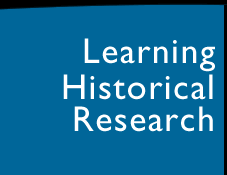Learning to Do Historical Research: A Primer
What Are the Documents?
Finding Your Evidence
Stillman Wagstaff
Jesse Gant
Introduction
Now that you have successfully identified your research question, you need to find the places where your early answers might exist. This page will guide you through the process of imagining the kinds of evidence that may exist and finding the sources that do exist. Short of answering your respective research questions, we hope that this page helps you think creatively about ways to go about your research. Having asked a question you want to answer, you will begin to see how the relationship between questions and sources allows each to shape the other. Through this page, you will discover that your research questions and your documents are actually mutually composed.
Table of Contents
Imagining Your Ideal Source
Discovering the Available ‘Real’ Sources
After the Evidence: Re-working Your Research Question
Primary and Secondary Sources
Seven Basic Types of Documents
Dos and Don’ts
Try This
Links and Works Consulted
Imagining Your Ideal Sources
Once you’ve framed your research question, you might feel ready to head to the library or the field and start finding answers to your question. While this is an important part of research, don’t get so wrapped up in finding sources that you overlook an important step that can save you a lot of time and energy: imagining your ideal sources. As you go about tracking down possible answers to your question, try to imagine exactly what you would most like to find, if you could find anything. What your ideal sources are will depend on the questions you are asking, but may take many forms. Ask yourself: “If I could design any piece of evidence that would contain the most interesting, comprehensive, provocative, or compelling information, what would it look like?”
For example, imagine that you wanted to know more about the poet and Black Hawk Island, Wisconsin resident Lorine Niedecker.
Your research project might try to document what her views on flood ecology and the spring floods of the Rock River were at the time she wrote her poem “Paean to Place.” What might your ideal sources look like? Here’s a partial list:
- The poem “Paean to Place.” The poem itself, since it is written about Black Hawk Island, might contain several clues to Niedecker’s feelings about the flooding. You might also imagine finding earlier manuscript versions of the poem, or previous drafts that were never published.
- An interview with the poet herself. Since Niedecker is dead, you might hope instead to find an interview conducted at the time of the poem’s composition in which the poet was asked “How do you feel about the yearly floods that affect your home town?” along with several other follow-up questions.
- Periodical sources. You might imagine finding an op-ed article or letter to the editor by Niedecker on the topic in a local newspaper.
- Private manuscripts. Perhaps you imagine your ideal source as a document written in Niedecker’s private notebooks entitled “My Thoughts on the Annual Flooding of the Rock River” that consisted of several pages of written feelings along with citations of important works that had shaped her thinking on the topic.
- Personal correspondence (published or unpublished). Maybe your ideal source is a letter to a friend about the flooding written in one of the months she was known to have been composing or drafting “Paean to Place.”
While it’s unlikely that any of your ideal sources exist in the exact form that you want them to, thinking of ideal sources helps you to expand the realm of the possible and look for documents in places you wouldn’t normally consider. You might want to write down a ‘wish list’ of ideal sources. If you do this, be sure to continually revise and update it throughout the research process.
Return to Top of Page
Discovering the Available ‘Real’ Sources
The next step in this process involves determining how your ideal sources correspond to real sources that you can find and use. In order to find out what documents currently exist in relation to your question, you will have to become acquainted with the realm of the actual (not just the possible). This means finding out what real documents exist and how they can be accessed.
In the example of Lorine Niedecker mentioned earlier, you would begin by trying to find real versions of your imagined ideal sources. In doing so, you would discover that Niedecker’s cabin on Black Hawk Island is just a few miles west of Fort Atkinson, Wisconsin, near where the Rock River enters Lake Koshkonong.
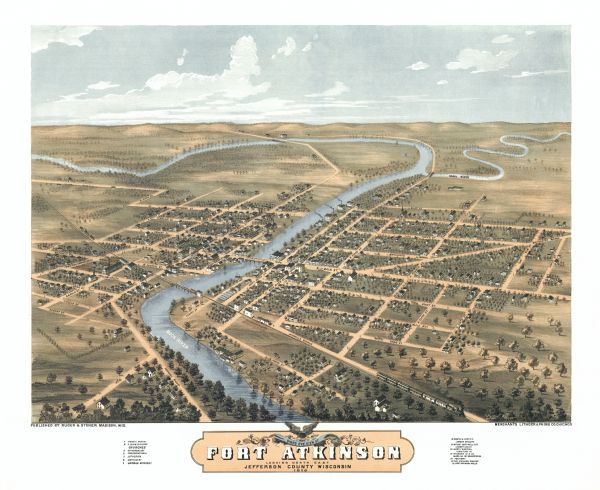
Bird’s Eye view of Ft. Atkinson, Wisconsin Historical Society, WHi-11413
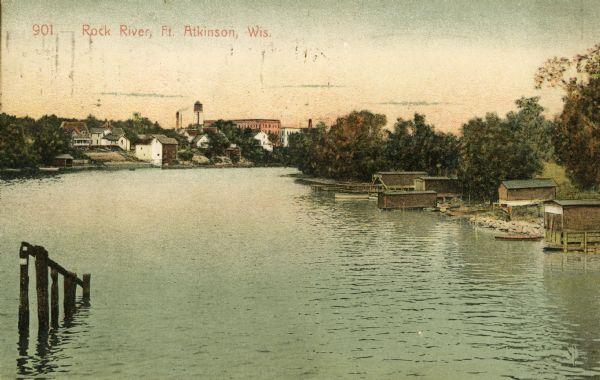
Rock River near Ft. Atkinson, 1909, Wisconsin Historical Society, WHi-31191
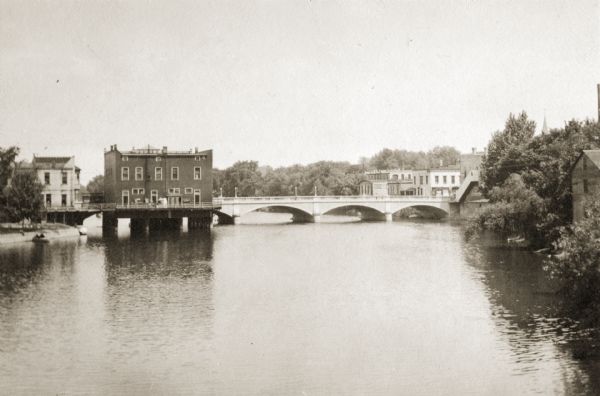
Main Street Bridge, Ft. Atkinson, 1915, Wisconsin Historical Society, WHi-3118
You’d also learn that the local newspapers were the Daily Jefferson County Union and Fort Daily News, and that old issues of these newspapers exist on microfilm at the Wisconsin Historical Society (among other places). You would also learn that many of Niedecker’s books and letters have been collected and are now housed at the Dwight Foster Public Library and the Hoard Historical Museum in Fort Atkinson, Wisconsin.
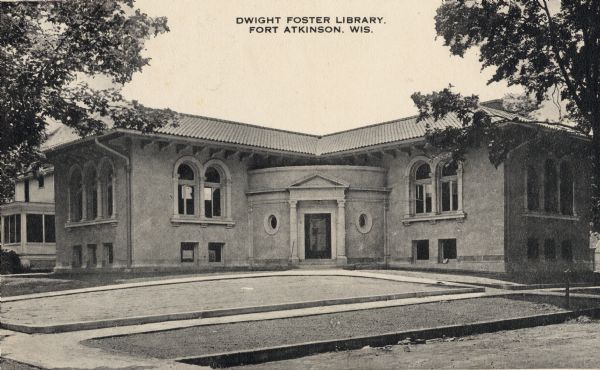
Dwight Foster Library, 1915, Wisconsin Historical Society, WHi-31138
Other materials (like letters from Niedecker to other literary friends) are housed in the Harry Ransom Humanities Research Center at the University of Texas, Austin and can be searched through their database. Of particular interest would be the collected papers of Louis Zukofsky, a poet and one of Niedecker’s closest literary friends. You’d also discover that the poem itself has its own textual history, best traced in Niedecker’s Collected Works, edited by Jenny Penberthy. Additionally, you could use the resources gathered by the Friends of Lorine Niedecker society to form a bibliography of printed materials that seems most relevant to your research question: http://www.lorineniedecker.org/bib.html.
Whatever your question may be, your job during this stage of your research is to begin to amass your own archive of real documents that might have answers to your research question. As you do this, keep in mind the following basic principles regarding historical documents:
- Documents always exist within space and time. While this may appear obvious to you, the corollary to this principle is that documents are always the products of a particular place and time. Recognizing that all documents come from their own place and time should lead you to think creatively about your sources, since the incomplete nature of all documents encourages multiple ways of seeing, reading, and interpreting them.
- Anything can be a document. If you are creative enough, almost everything can be potentially useful for you as a researcher. While this is exciting, remember: not all documents are equally valuable.
- A document’s value depends on how it can be used in a given situation. For example, if you’re trying to understand how nineteenth century irrigation practices changed the vegetative patterns in southern Utah, the Declaration of Independence would be completely worthless to you, even though it is a historically valuable document. Conversely, something that seems totally worthless to society at large, like Niedecker’s private journals, could be incredibly valuable to you, depending on the nature of your research question. You determine how valuable a document is by the ways that you put it to use.
- Very interesting research projects can begin with the documents themselves. For example, imagine that while helping some friends remodel their basement you come across a shoebox full of internal memos on the environmental impact of new insecticides written by executives of a major pest control company. In this case, you already have a rich and previously undiscovered set of documents, so your next step might be asking “What are the most interesting questions I can ask of these documents?”
- The best relationship between questions and documents is flexible and reciprocal, not rigid and predetermined. While you usually begin with a research question and then search for documents, you can reverse the order of these two steps. As you try to match up your ideal sources with real documents, you’ll probably end up changing your research questions in some way. You may even find yourself altering or abandoning your hypothesis in order to accommodate what you do and do not find. Remember, it's common even for experienced researchers to do this—and you will likely discover some of your best questions and insights in just this way. Unpredictability is a big part of why research is so exciting.
Avoiding Common Errors: Confirmation Bias and Lack of Focus
So, what should you do if you can’t find (or access) any of your ideal documents? When should you discard or change a research question based on the lack of available documents? Ideally, all research projects should report their findings honestly. Responsible researchers do not force data into preconceived notions, nor do they simply regurgitate the ideas of others. Rather, they are critically engaged with their documents, realizing that the questions they ask and the perspectives from which they examine these documents largely determine what they can yield.
Striking the right balance between ideal and actual sources is always difficult, since even the most experienced researcher has no way of knowing in advance what they’ll find, nor can they predict which lucky accidents will accompany their research. There are, however, a few common mistakes that you should be sure to try to avoid.
On the one hand, avoid the tendency to think that you already know the right answers to the questions that you are asking. While you may have a hypothesis that begins to explain the events you are interested in, you should not approach research as a process in which you gather as much evidence as you can to support your point of view. Researchers who work this way often fall victim to something called confirmation bias, which means that they notice only the information that confirms their preconceptions. Confirmation bias will lead you to ignore any evidence that doesn’t match up with your hypothesis and will place artificial limits on what you can learn about the past. It is also intellectually dishonest and can lead to major problems.
On the other hand, you’ll also have problems if your questions lack enough focus, or if you haven’t decided the perspective from which you want to examine the documents you do find. If your questions are too broad, you won’t be able to distinguish useful from useless documents. Not only that, but if you haven’t decided exactly what you’re looking for, you won’t be able to identify the most valuable parts of what you do find.
If you feel inexperienced in the field and are intimidated by how much information is out there, you might even be tempted to enter a research situation with a very broad question and proceed completely blindly. Maybe you believe that if you just get in among the documents some kind of magic will transpire, serendipity will guide you safely through, and the research paper will write itself, like it did in high school. This is almost always wishful thinking. As William Cronon has noted, “only by planning your research in advance will you cover enough ground and ask enough questions to recognize the unexpected when you stumble upon it” (from the How to Write a Research Prospectus document, hosted elsewhere on this site).
You can avoid these dangers by doing the following:
- Start with a sincere question that could be answered in multiple ways.
- Make sure your research question is specific enough that you can imagine what some ideal sources might look like.
- Have a rough idea of what you’re hoping to find and a plan for how to proceed with what you do find.
- Approach your documents from many different perspectives and use different imaginative lenses to see the same thing from multiple points of view.
- If you find convincing evidence that leads you away from your initial hypothesis, change your hypothesis.
- Don’t draw conclusions until after you’ve found and searched your documents.
Just as planning and execution are each important stages in the production of artworks and buildings, flexibility and preparation are complementary aspects of nearly all successful research projects. Wandering aimlessly around the library without proper preparation is obviously a recipe for disaster. However, no matter how much you’ve prepared, you can be sure that some aspect of your research will lead you in an unexpected direction.
Returning again to the example of Lorine Niedecker, you would probably be disappointed to discover that for most of her lifetime she lived in relative obscurity, meaning that there aren’t as many relevant primary documents as you would have hoped. The local newspaper didn’t interview her, and there were very few people who took enough note of her poetry to seek her out and interview her in her own lifetime. Also, her husband burned many of her private papers after her death, which means that it’s possible that some of your ideal sources don’t exist anymore. While all this would be disappointing, it still wouldn’t mean that your project was a complete failure.
Remember that how you imagine your ideal source will change depending on the real sources you find. In this case, based on what you found, you might decide that it is too difficult to find out what Niedecker’s personal views on the flooding were. You might decide instead to try to place Niedecker’s poem into a historical context by researching other responses to the flooding of the river by her contemporaries. Perhaps you found some really compelling stories in the local newspaper about the flooding, or an image like the following (a picture of Ft. Atkinson during recent flooding) which has led you to an entirely new research question.
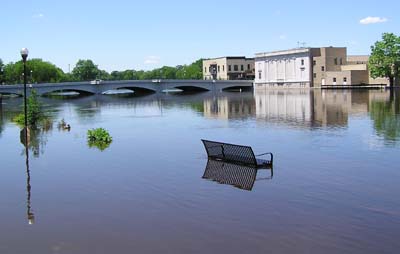
Rock River flood, Ft. Atkinson, June 3, 2004
(Photographer:
Scott Catron, Published on Wikipedia Commons)
This new research question won’t be exactly the same as the one you started with, but it is likely to be connected to your original idea, and the process of imagining ideal sources and finding real documents will have been crucial in shaping and refining it.
With every research project that you undertake, you’ll find some things that you never would have imagined existed, and you’ll also be really disappointed to find some things you thought would be easy to find don’t exist at all. The more experience you have in searching for and finding documents, the better able you will be to imagine the real documents that might exist. As you begin to have more research experience, you will also develop a better idea of what kinds of questions are most likely to have ready answers.
Return to Top of Page
After the Sources: Rebuilding Your Questions
Let’s take a slightly different tack and assume that you have found some documents that seem directly relevant to your topic and research question. With all this early progress and good fortune, it may seem like your research is over. But much like what happens when you cannot come up with your ideal sources, assembling good evidence will only give rise to other research problems. The following should illustrate what we mean:
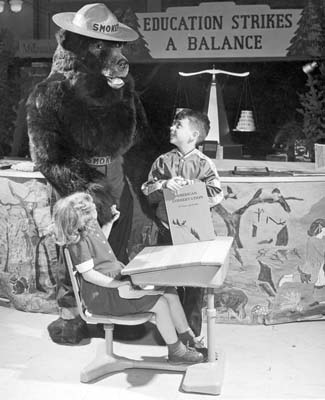
Smokey the Bear With Schoolchildren, 1954
Wisconsin Historical Society, WHi-6791
In this example, let’s say you are researching a question related to the individuals and groups responsible for integrating Smokey the Bear into Wisconsin’s education curriculum after World War Two. In your research, you discover this photograph in the Wisconsin Historical Society showing schoolchildren with Smokey in Milwaukee in 1954. The photo demonstrates that Smokey was being used in the Wisconsin schools by 1954. But this photo also begs more questions:
- Whyis the boy holding a copy of a book named American Conservation?
- Doesthat book still exist? Might you be able to find it at the local library?
- Ifit does exist, will it tell you something important about this image, or moreimportantly, something crucial to your original research question aboutthe groups and individuals responsible for incorporating Smokey into thecurriculum after World War Two?
The broader point is that while this photo gives us some evidence around which to structure our project, it does not necessarily answer our existing research question about the individuals and groups responsible for making Smokey the Bear an integral part of the school’s curriculum after World War Two. Here are some basic tips meant to help you re-build your research questions after you have uncovered some crucial early documents. As the documents and your questions begin to speak with one another, you will quickly learn that this reflexive dialogue is often the most rewarding part of your research.
- Retain a healthy dose of skepticismabout every document you encounter. Remember that all documents havetheir own history, and that all documents lie. Here is a good example of what we mean. Let’s say youwere interested in grain commodities after the Civil War because you are interestedin the environmental effects of industrialized wheat farming in the UpperMidwest during that period. Yourearly research led you to the McCormick International Harvestercollections at Madison, Wisconsin.Inside that manuscript collection, you encounter this:

McCormick "Battle of Gettysburg" Advertisement
Lithographed advertising poster
showing a McCormick grain binder at the Civil War Battle of Gettysburg
Produced for the McCormick Harvesting Machine Company
by the Central Lithography & Engraving Company of Chicago.
Wisconsin Historical Society, WHi-3563
How would a McCormick grain binder from the 1880s end up getting stuck between the battle lines during the fighting at Gettysburg in 1863? Obviously, the ad is playing a clever trick on you, the viewer. In 1886, the McCormick Harvesting Machine Company used an ad campaign in which its harvesters made a series of ahistorical appearances at a number of famous Civil War battles. This ad may seem completely unrelated to your question about the environmental effects of industrial grain production in the Upper Midwest after the Civil War. But what this example does demonstrate is that even the most blatant lies in the documents can be interpreted to reveal important lessons about the past. If a document doesn’t seem to speak to your question outright, at least make sure you take note of the things that seem interesting or somehow loosely related to your question. What you might find is that something as odd as an advertisement like this will eventually help you answer, in this example at least, one of your questions about how industrial agriculture triumphed in the years after the Civil War.
- Remember that documents in many waysmirror the politics and mood of their own unique moment and place ofproduction. After all,putting words to text is never as simple as it may seem, and should hardlybe taken for granted when doing environmental history—or any scholarlyproject. Here are two imagesfrom a book produced by the Wisconsin Department of Instruction in 1949that was meant to help teachers implement lessons of conservation.
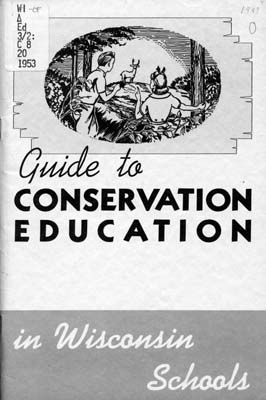
Guide to Conservation Education in Wisconsin Schools
Wisconsin Cooperative Educational Planning Program
Bulletin No. 20, August 1949
(cover)
Wisconsin Historical Society 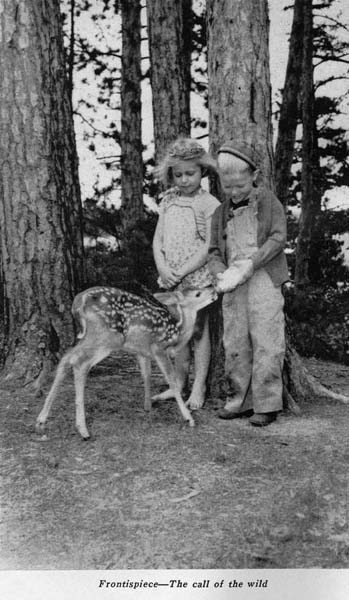
Guide to Conservation Education in Wisconsin Schools
Wisconsin Cooperative Educational Planning Program
Bulletin No. 20, August 1949
(Frontispiece, p. 2)
Wisconsin Historical Society
Compare them with this cover image from a book put out by the Wisconsin Historical Society Press in 1999, called Learning from the Land: Wisconsin Land Use.
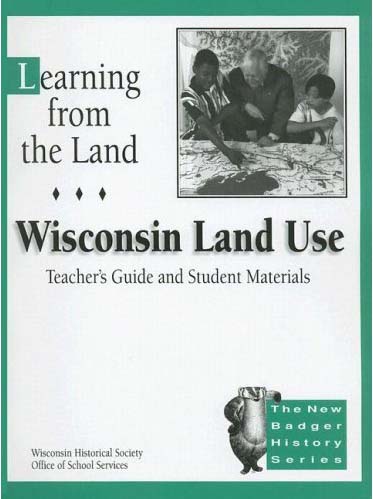
Learning from the Land: Wisconsin Land Use
Wisconsin Historical Society Office of School Services, 1999
(cover)
Ask yourself: In what ways do these images reflect changes in the politics and society in the fifty year period between 1949 and 1999? Could these images be used to situate a broader claim about the origins of postwar conservation politics? Might they be put into dialogue for a paper about the political limits of early conservation movements?
Just because you cannot connect your research question with the related documents DOES NOT mean your questions are invalid. As you saw before in the example of Lorine Niedecker, in those instances when your research just doesn’t seem to yield the kinds of evidence you might have hoped for, it is important not to lose sight of the fact that every lost opportunity can be turned into a new opportunity for research. Just because the documents do not exist doesn’t mean you should abandon your project.
Let’s say you have a question about the impact of disease upon Black Hawk’s people during his fabled military campaign through southern Wisconsin and northern Illinois in 1832. You discover one document that quickly leads to the discovery of one other crucial document. But neither of them details anything specific about disease’s effects during the campaign.
First, you discover this painting of the militia leader Henry Dodge after searching “Black Hawk War” on the web.
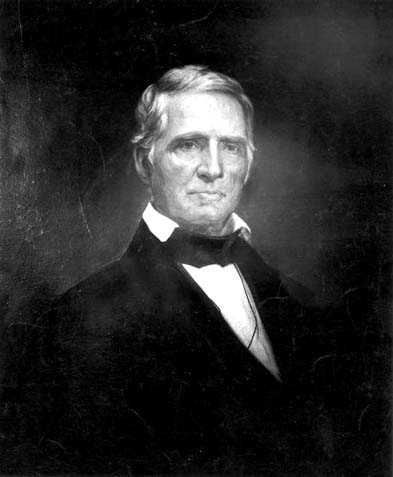
Henry Dodge Portrait
(painted by William Cogswell, 1819-1903)
Wisconsin Historical Society
Then, curious about the significance of Dodge’s role in the Black Hawk War, you run a search for his name on WorldCat. You learn that his papers are at the State Historical Society of Iowa, and so you look up the record for his papers in their library holdings.
The record indicates that Dodge’s papers do include correspondence from the year 1832. You might wonder: Did Dodge. as a participant in the campaign, write about the effects of disease either among his own soldiers or in his writings about the Native Americans? In any case, you can’t know answers to these questions outright. You will have to look at that correspondence file in order to know. But hopefully this example shows that sometimes documents that seem unrelated to your question can end up pointing your work in helpful directions.
Gaps and silences often speak louder than words. As you move through the sometimes frustrating process of reconciling ideal sources with the real ones, you should remember that gaps in our documents can be made to speak. You can learn important lessons by attempting to understand why certain evidence no longer exists, or why some documents were not produced in the first place.
Return to Top of Page
Primary and Secondary Sources
Environmental historians distinguish between primary and secondary sources for reasons of utility. What you will quickly discover is that their definitions of primary and secondary sources are often intentionally arbitrary. What constitutes a primary or secondary source, in other words, often depends upon the nature of the research question being asked. We suggest that with every document you encounter, you ask yourself to think of questions that would shift the conception of a particular source from primary to secondary and vice versa. Doing so will expand your thinking about how research questions can shape the way you use certain documents as evidence.
You might also want to check out the handbook, History and Critical Thinking: A Handbook for Using Historical Documents to Improve Students’ Thinking Skills in the Secondary Grades, produced in 2005 by archivists and librarians at the Wisconsin Historical Society. Chapter five in the handbook has some great information on how to use the society’s digital collections as primary sources.
You can download the handbook here: http://wisconsinhistory.org/turningpoints/pdfs/workshophandbook.pdf
Primary Sources
The primary source is the one that has the closest relationship in both time and space to the subject you are studying. This often implies a documentary relationship, but even this definition is flexible. We tend to think of an early conservationist’s diary as a primary source, but the conservationist’s clothing, routes of travel, and work locations could also be used primary sources. Here are some documents that would likely be considered primary in an environmental history of Hurricane Katrina.
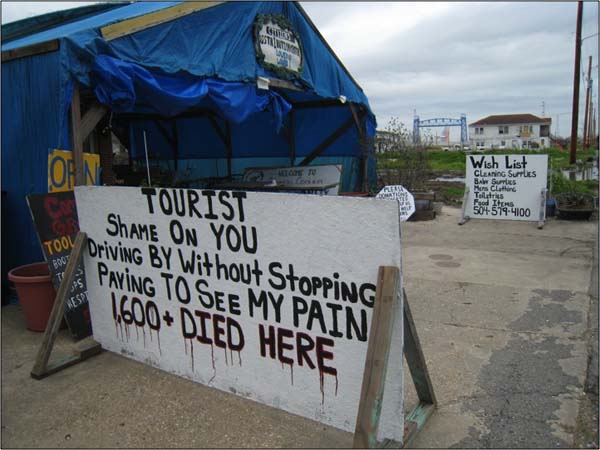
Ninth Ward Tourist Sign, New Orleans
(photo by William Cronon)
- Photographs taken of the New Orleans region in August, 2005
- Interviews with residents taken immediately after the storm
- Transcripts of police communications throughout August and September, 2005
Secondary Sources
The secondary source addresses themes or subjects directly related to or explicitly “about” a primary source. Historians, journalists, politicians, and others who might cite primary sources may comment on, interpret, or otherwise summarize the stuff of primary material in order to condense it or build an argument from it. This process yields work we would then call secondary to the primary material. Here are some examples that might be considered secondary in the construction of an environmental history of Hurricane Katrina.
- The Great Deluge: Hurricane Katrina, New Orleans, and the Mississippi Gulf Coast, a history published in 2006 by Douglas Brinkley.
- When the Levees Broke: A Requiem in Four Acts, a documentary directed by Spike Lee about Hurricane Katrina, released in 2006.
Again, notice that these distinctions are often somewhat arbitrary. A future historian wanting to know how historians in the period between 2005 and 2010 interpreted Hurricane Katrina will undoubtedly treat Douglas Brinkley’s book as an important primary source.
Return to Top of Page
Seven Basic Types of Documents
Obviously, no single website will be able to provide a thorough introduction to every type of document. Recognizing your constraints, we have chosen to focus on seven types of essential documents that we feel will be most useful in the broadest number of potential research situations. Each of the following bullet points will link you to a page detailing how to find and use a different type of source in your research of Environmental History.
Return to Top of Page
- Do use your imagination in structuring your approach to research.
- Do make a list of your ideal sources, updating it as you encounter real documents.
- Do think of documents as products of a particular time and place.
- Do remember that great research projects often spring from accidents and other lucky finds within the evidence.
- Don’t forget that all documents lie. Approach them critically!
- Don’t get discouraged if your imagined evidence doesn’t live up to the real evidence you discover.
- Don’t forget to think critically about whether your sources are primary or secondary. Ask how certain questions might shift their fundamental conceptualization.
- Don't forget to put your evidence into dialogue with your research questions. This may be the most important part of the research process.
Return to Top of Page
Ask yourself how you would go about writing an environmental history of your own home. What documents would you need to write that history? What would be the ideal kinds of sources and where might you find them? As an exercise, pick an item from your favorite room and ask what documents already exist to explain and identify it.
Check out William Cronon’s “Places to Find Sources About Your Place” section within his website for writing place papers. Walk yourself through some of the tips described there and reflect on how you might use some of those suggestions in your thinking about where to find documents. The page can be found here: www.williamcronon.net/courses/460_place_paper_assignment.htm
Return to Top of Page
Works Consulted and Interesting Links
Books
Douglas Brinkley, The Great Deluge: Hurricane Katrina, New Orleans, and the Mississippi Gulf Coast, (New York: Morrow, 2006)
Bobbie Malone, Learning from the Land: Wisconsin Land Use. Teacher’s Guide and Student Material, (Madison, WI: State Historical Society of Wisconsin: U.S. Department of the Interior, Bureau of Land Management, 1998)
Guide to conservation education in Wisconsin schools. (Madison, Wis.: Dept. of Public Instruction, 1949).
Documentaries
When the Levees Broke: A Requiem in Four Acts. DVD. Directed by Spike Lee. New York: Home Box Office, (HBO) Inc., 2006
Manuscript Collections
Henry Dodge Papers, University of Iowa
McCormick Harvesting Machine Company, Wisconsin Historical Society
Louis Zukofsky Collection, Harry Ransom Humanities Center, University of Texas, Austin: http://www.lib.utexas.edu/taro/uthrc/00138/hrc-00138.html
Websites, Resources, and Repositories
History and Critical Thinking: A Handbook for Using Historical Documents to Improve Students’ Thinking Skills in the Secondary Grades
http://wisconsinhistory.org/turningpoints/pdfs/workshophandbook.pdf
Hoard Historical Museum
http://www.hoardmuseum.org/page.asp?content=1.asp
Lorine Niedecker, 1903-1970
http://www.lorineniedecker.org/bib.html
William Cronon’s Place Paper Assignment
http://www.williamcronon.net/courses/460_place_paper_assignment.htm
The Wisconsin Historical Society
www.wisconsinhistory.org
Return to Top of Page
| 